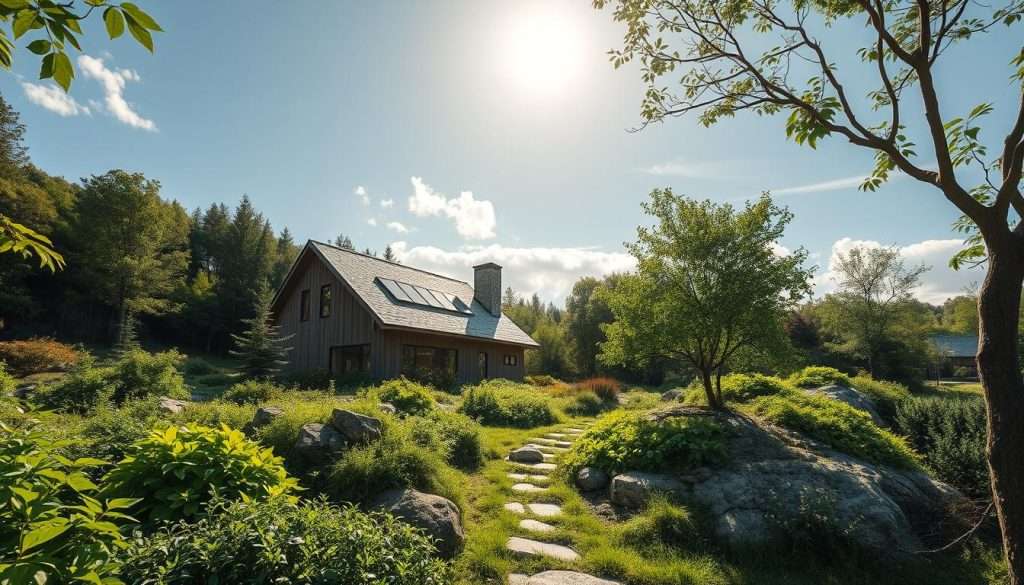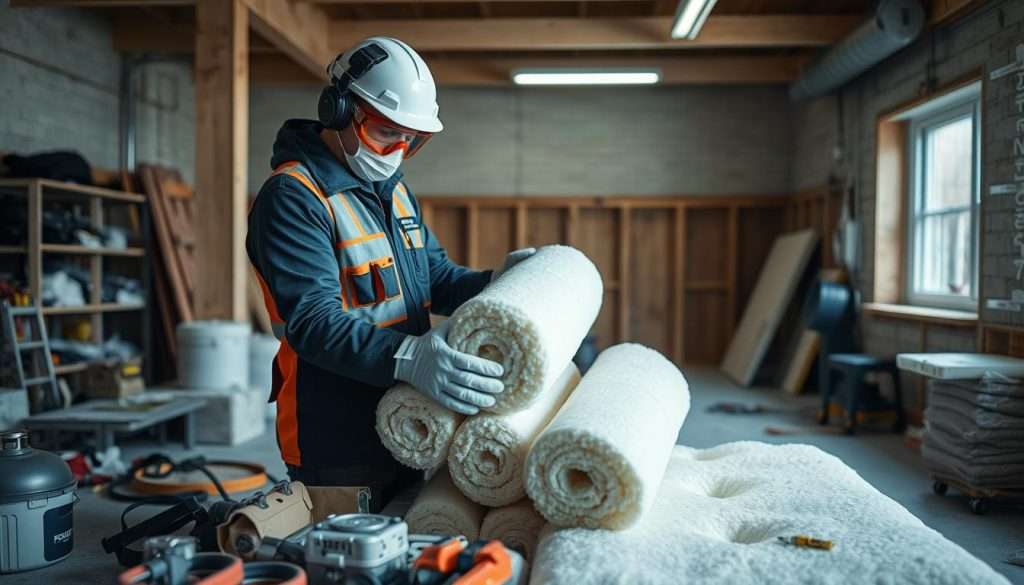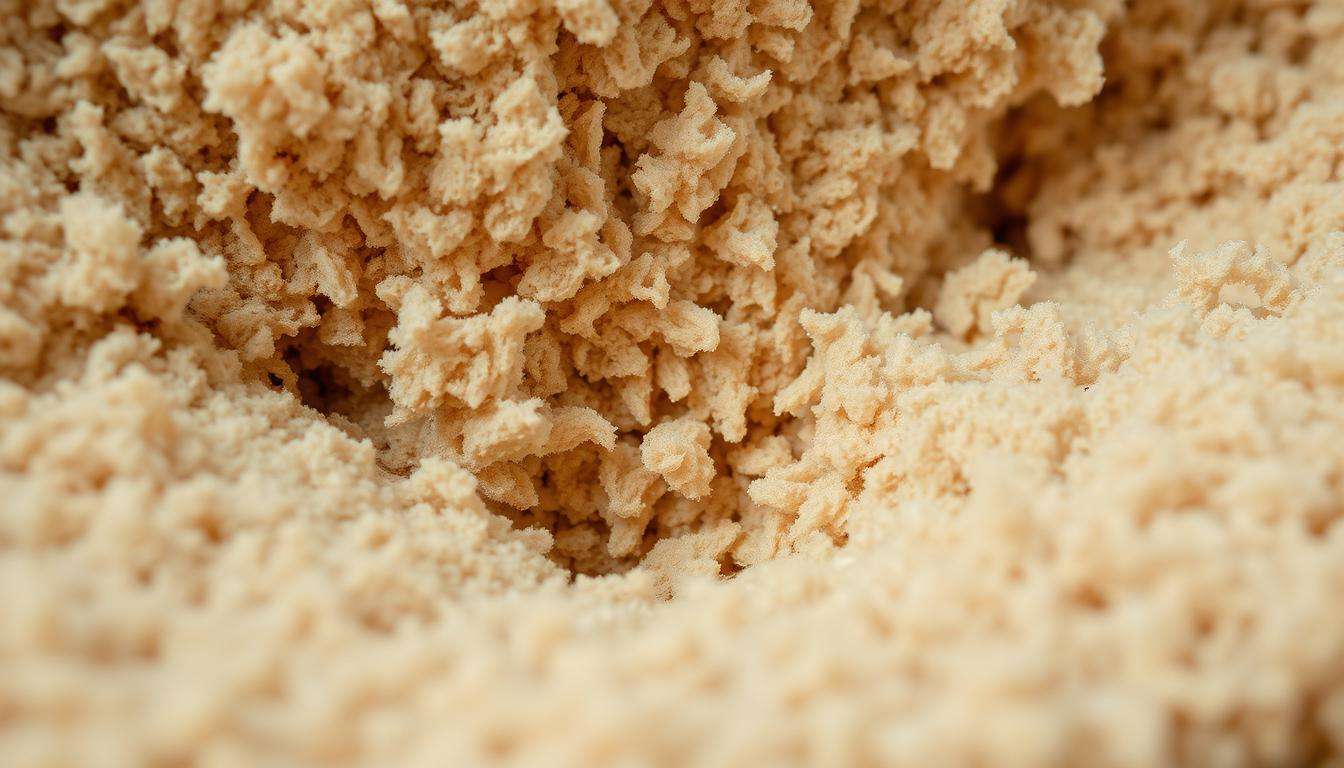Rockwool insulation, also known as mineral wool, is a top choice for homes. It’s made from molten rock and recycled slag. These are spun into fibers that look like cotton candy. This guide will tell you all about its benefits and how to use it.
Rockwool keeps your home warm, safe from fire, and quiet. It can handle very high temperatures without melting. This makes it a great choice for insulation.
Key Takeaways
- Rockwool insulation is made from molten rock and recycled materials.
- It offers superior thermal performance with an R-value that surpasses fiberglass insulation.
- This insulation type excels in fire resistance and is moisture-resistant.
- Rockwool provides substantial soundproofing capabilities, allowing for quieter spaces.
- Understanding various applications helps determine if it’s suitable for your needs.
Introduction to Rockwool Insulation
Knowing about rockwool insulation is key for homeowners and builders. It keeps your place warm and quiet. It also stops fires. Rockwool is loved for its many benefits.
Definition of Rockwool
Rockwool is made from natural rock and recycled stuff. It’s very dense, making it great for keeping things warm or cool. It also blocks sound and stops fires.
- Excellent thermal insulation
- Remarkable rockwool soundproofing capabilities
- High fire resistance
It’s a top pick for homes and businesses. People call it mineral wool. It’s strong and works well for a long time.
How It Is Made
Making rockwool is a special process. First, they melt rock and steel slag. Then, they spin it into fibers.
This makes air pockets that keep things warm or cool. Here’s a quick look at its density:
| Application | Density (kg/m3) |
|---|---|
| Blankets | 23 |
| Common Applications | 30 to 80 |
| Under Load | 90 to 150 |
Rockwool comes in batts, rolls, and sheets. It keeps working well over time. It’s a smart choice for any home.
Benefits of Using Rockwool Insulation
Rockwool insulation is great for homes and businesses. It helps save energy, keeps buildings safe, and makes them more comfortable. Let’s look at why rockwool is so good.
Thermal Performance
Rockwool insulation is top-notch when it comes to keeping buildings warm or cool. A 3.5-inch layer of it has an R-value of 15. That’s better than fiberglass, which has an R-value of 13 for the same thickness.
This means your energy bills can go down. Rockwool keeps the heat in during winter and out during summer. It’s a big win for your wallet.
Fire Resistance
Rockwool insulation is also super safe from fires. It can handle temperatures up to 2150°F without melting or giving off bad fumes. This is way better than fiberglass, which starts to melt at about 500°F.
Rockwool’s special mix makes it safe and gives you peace of mind. It’s a big plus for keeping your home safe from fires.
Soundproofing Qualities
Rockwool is also great at blocking out noise. Its dense fibers soak up sound really well. This makes it perfect for places where noise is a problem.
In fact, rockwool can block over 50% of outside noise. This is especially helpful in apartments or near busy streets.
Applications of Rockwool Insulation
Rockwool insulation is used in many places. It helps save energy and keep things safe. It’s good for homes, offices, and factories.
Residential Uses
Rockwool batts are great for homes. They make homes more energy efficient and cozy. They are used in:
- Wall insulation for better energy use
- Attic insulation to stop heat loss
- Basement insulation to keep a steady temperature
Rockwool keeps homes warm in winter and cool in summer. It’s better than fiberglass.
Commercial Uses
Rockwool is also used in offices and shops. It helps with sound and fire safety. You can find it in:
- Office spaces to block noise
- Retail outlets for a better shopping experience
- Schools for safer classrooms
Rockwool fits well in many commercial buildings.
Industrial Applications
In factories, rockwool insulation is key. It keeps equipment safe and saves energy. It’s used for:
- Insulating pipes and equipment
- Protecting against high heat
- As loose-fill insulation for tanks and ovens
Rockwool helps stop fires in dangerous places. It keeps buildings and people safe.
| Application Type | Benefits | Common Uses |
|---|---|---|
| Residential | Energy efficiency, comfort | Walls, attics, basements |
| Commercial | Sound control, fire safety | Offices, schools, retail |
| Industrial | Fire safety, thermal efficiency | Equipment, piping, ovens |
Types of Rockwool Insulation
When picking insulation, knowing the types of rockwool insulation is key. Each type has its own use and benefits. We’ll look at batts, loose fill, and rigid boards.
Batts and Rolls
Rockwool batts and rolls are easy to use in walls and ceilings. They keep your home warm and quiet. They beat fiberglass in keeping heat in.
Loose Fill
Loose fill rockwool is great for attics and odd spaces. It fills gaps to stop heat loss. It makes your home more energy-efficient.
Rigid Boards
Rigid boards are strong for roofs and walls. They keep your home warm and dry. They’re denser than fiberglass, making them last longer.
| Type | Application | Key Benefits |
|---|---|---|
| Batts and Rolls | Wall cavities, ceilings | Easy installation, high thermal resistance, excellent soundproofing |
| Loose Fill | Attics, irregular spaces | Fills gaps, prevents heat loss, versatile |
| Rigid Boards | Roofs, foundation walls | High compressive strength, robust thermal insulation, moisture resistance |
Knowing about rockwool batts, loose fill, and rigid boards helps you choose the best. It makes your home cozy and energy-smart.
Installation Process of Rockwool Insulation
Installing Rockwool insulation is a step-by-step process. It makes your home more energy efficient and comfortable. It’s easy for anyone to do, whether you’re a homeowner, builder, or DIY fan.
Preparation Steps
Before you start, you need to do a few things:
- Finish all electrical work first to stay safe.
- Check the area for leaks or mold.
- Wear gloves, goggles, and dust masks for protection.
- Make sure to seal all gaps for a tight fit.
When you’re working with old insulation, make it even. Then, place Rockwool Comfortbatt on top. Press the batts together tightly for better insulation.
Installation Techniques
Here are some tips for installing Rockwool:
- Cut the insulation to fit the studs or joists well.
- Use friction or adhesive for extra hold, especially in loose areas.
- For ceilings, keep at least two inches of space from the roof deck to avoid moisture.
- In attics, use a baffle to keep air flowing and insulation near electrical things.
Rockwool insulation is very effective, with an R-value of 3.6 per inch. It lasts long without losing shape. For more on how to install Rockwool, see our detailed guide.
Rockwool Insulation vs. Other Insulation Materials
When picking insulation, knowing how Rockwool stacks up against fiberglass and foam board is key. Each has its own pluses and minuses. We’ll look at how they compare in terms of keeping warm, fire safety, and how green they are.
Comparison with Fiberglass
Rockwool beats fiberglass in a few important ways:
- Thermal Performance: Rockwool keeps better at R-15 with just 3.5 inches. Fiberglass tops out at R-13. Rockwool wins in insulation.
- Soundproofing: Rockwool’s dense build helps it soak up sound better. It’s great for quieting down spaces.
- Moisture Resistance: Rockwool’s density keeps moisture away. Fiberglass can soak up moisture, hurting its performance over time.
Comparison with Foam Board
Foam board has some downsides compared to Rockwool:
- Safety: Foam boards can release harmful gases because they’re made from petrochemicals. Rockwool is safe and non-toxic.
- Fire Resistance: Rockwool doesn’t burn and gets top fire ratings. Foam boards have lower ratings, which is a worry in homes.
- Thermal Performance: Foam board insulates well, but Rockwool does better because of its mineral makeup.
Environmental Impact
Rockwool’s green impact is big. It’s made from lots of recyclable stuff. Making it uses little energy and no bad chemicals. It’s a better choice for homes.
Here’s a table showing how Rockwool stacks up against other insulations:
| Insulation Type | R-Value (per 3.5 inches) | Fire Rating | Environmental Impact |
|---|---|---|---|
| Rockwool | R-15 | A1/A2-s1, d0 | Made from recyclable materials, low energy use in production |
| Fiberglass | R-13 | Class E | Recyclable but sourced from non-renewable resources |
| Foam Board | Varies (typically R-12 to R-15) | B, C, D, E or F | Derived from petrochemicals, can emit harmful gases |

Cost Considerations of Rockwool Insulation
When picking insulation for your home, knowing the cost of Rockwool is key. Rockwool insulation is durable and works well in many places. This makes it a good choice for your home.
Material Costs
Rockwool insulation costs between $1.40 to $4.00 per square foot. It’s a good deal compared to other materials like wood fiber. Here’s a comparison:
| Insulation Type | Cost per Square Foot |
|---|---|
| Rockwool | $1.40 – $4.00 |
| Wood Fiber | $4.25 – $6.75 |
| Cellulose | $0.60 – $2.30 |
| Polystyrene | $0.25 – $0.50 |
Installation Costs
Some people install it themselves, but hiring pros costs more. Installation can cost around $1,819. This is about $0.29 to $6.74 per square foot. Getting it done by a pro can make it work better.
Long-Term Savings
Rockwool insulation saves money in the long run. It lowers your energy bills. This makes it good for the planet and your wallet. Rockwool lasts a long time, making it a smart investment.
Maintenance and Longevity
Knowing how long rockwool lasts is key for those who want durable insulation. Rockwool keeps your home warm and quiet for decades. It’s a smart choice because it lasts a long time.
Expected Lifespan
Rockwool insulation lasts over 50 years. It keeps your home warm for more than 55 years. Studies show it works well for 20 to 55 years.
ROCKWOOL stone wool insulation lasts over 65 years. This means you save energy for a long time.
Maintenance Tips
To keep rockwool in good shape, you need to check it often. Here are some tips:
- Check for settling or damage in the insulation.
- Fix any spots where insulation is squished.
- Keep moisture away from the insulation.
- Insulate new areas to keep everything efficient.
By following these tips, your rockwool insulation will last longer. Your home will stay cozy and save energy for years.
Safety Considerations
When picking rock wool insulation for your home, safety is key. Knowing how to handle it and its health effects makes installation safer.
Handling Precautions
Rock wool insulation is mostly safe, but handling it right is important. Here’s what to do:
- Wear gloves, a mask, and goggles to avoid irritation from dust and fibers.
- Make sure the work area has good air flow to cut down on dust.
- Keep products in a cool, dry place indoors, away from heat.
Health Effects
Studies say rock wool insulation is not cancer-causing and is safe. It releases very few fibers during installation. This is in line with safety limits set by OSHA and ACGIH:
| Guideline | Exposure Limit |
|---|---|
| OSHA Recommended PEL for Synthetic Vitreous Fibers | 1 f/cc TWA |
| ACGIH TLV for Synthetic Vitreous Fibers | 1 f/cc TWA |
| Inhalable Particulate Exposure Limit | 10 mg/m3 TWA |
| Respirable Particulate Exposure Limit | 5 mg/m3 TWA |
| Inert Dust Limit | 15 mg/m3 TWA |
By following these safety steps, you can lower risks from dust during installation. Many people feel safer knowing rockwool is safe to use.

Conclusion: Is Rockwool Insulation Right for You?
When picking insulation for your home, think about rockwool’s benefits. It keeps your home warm or cool well. It also stops sound and doesn’t catch fire up to 1000°C.
Rockwool is thin but insulates a lot. It works well in homes and businesses. This makes it a great choice for many places.
Key Takeaways
Rockwool lasts a long time and fights off moisture, mould, and pests. It’s also good for the planet because it’s made from natural and recycled stuff. But, it might be heavier and cost more than other insulations.
For more info on its benefits and uses, check out this resource on rockwool insulation advantages.
Final Recommendations
Rockwool is a solid choice for insulation. Think about what you need and the costs. Rockwool makes your home more energy-efficient and saves money on bills.
